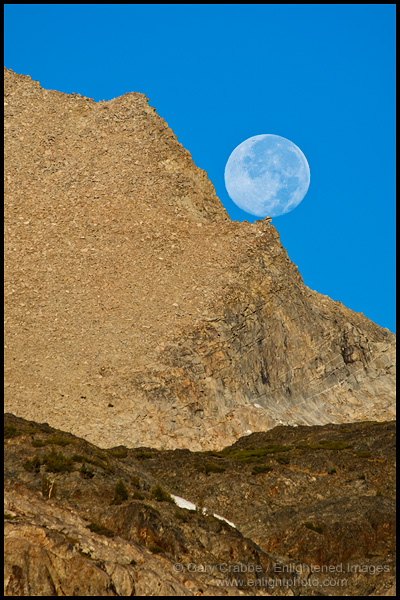Picture: “Balance this!” – Full moon setting over mountain ridge along the Sierra crest, near Tioga Pass, Eastern Sierra, California

In photojournalism, the first thing you learn is “The Moment is Key.” The meaning of this is simple. If you don’t have an image that tells a story or reveals a peak moment in the action, you don’t have the shot. The same holds true for a lot of wildlife photography that focuses on behavior.
On the other hand, most people think nature photography, especially with landscapes, is very static. However, there’s no reason why some landscapes can’t be approached with the same goal as photojournalism; namely catching that one defining peak moment of action. A great example is an ocean wave breaking against a rocky cliff.
While watching the moon set on this morning, I worked with several placements of the lunar disc as it hung in the sky. Most were nice, but none were especially satisfying. Then I noticed the one outcrop in the direction that the moon was traveling. I knew that if I moved my position slightly, I could align the moon so it would just touch the outcrop. It adds a sense of tension and drama at that one instant. Plus, the tiny bit of the moon that is obscured by the rock helps solidify the authenticity of the image, keeping at bay the potential doubters who would say that I just dropped the moon in with photoshop. (I didn’t, I swear!)

Very cool Gary! That’s the idea I had when I was at Arches National Park. (Click on my name to see.).
The scale you were able to pull off is amazing.
Hey Gary
Very cool. I love the placement here. Great shot.
Cheers
Carl
Gary, its attention to detail and seeing the possibilities like this that make you a real pro!
That is amazing! Your perspective is AWESOME!
The moon is in the perfect position for the most interest and tension as you say. The rocky promontories are interesting and different too. Impressive work.
Now, if you could had someone up on the ridge “pushing” the moon off the ledge. 🙂
(Great shot BTW)
This is awesome! Its especially captivating since the moon is large enough to be on the same scale as the peaks.
Very cool, Gary!